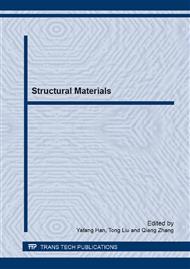p.351
p.357
p.362
p.367
p.372
p.378
p.384
p.390
p.396
Effect of Austenizing Temperature and Time on Microstructure and Mechanical Properties of Cr12MoVNbRE Steel
Abstract:
A new-type of Cr12MoVNbRE die steel was designed and investigated. The phase transition temperature was measured by dilatometer. Effects of austenizing temperature and time on the microstructure and mechanical properties of the Cr12MoVNbRE die steel were studied. The results show that the hardness decreases with the increasing austenitizing time. As for the austenitizing temperature, it increases firstly, and then decreases when the austenitizing temperature increases. The most suitable austenitizing temperature and time are 1010 °C and 20 min respectively. The high hardness of the Cr12MoVNbRE die steel is mainly attributed to the martensite with high alloy content and fine uniformly dispersed carbides.
Info:
Periodical:
Pages:
372-377
Citation:
Online since:
April 2014
Authors:
Keywords:
Price:
Сopyright:
© 2014 Trans Tech Publications Ltd. All Rights Reserved
Share:
Citation:


